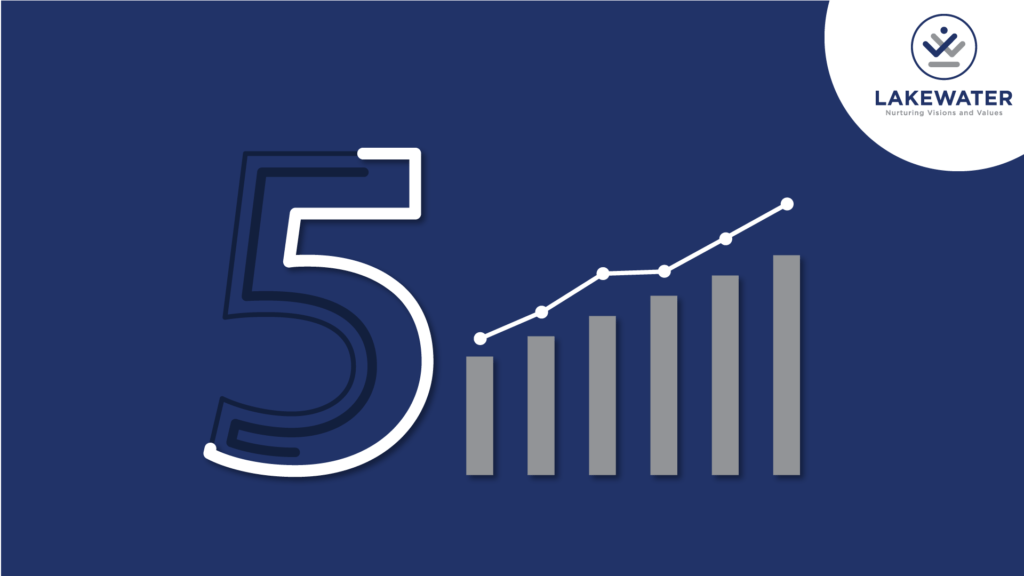Introduction
There has been immense debate about the Government’s ambitious target in the Union Budget 2019 of making India a $5 trillion economy by 2024. In the current environment of economic slowdown due to pandemic, this outlook now seems even more ambitious. However, India is fundamentally well-poised for a persistent growth drive; which makes Lakewater trust India’s growth story and be certain of it to be a dark horse.
The target is challenging but Indian economy has overcome and made a herculean climb ever since 1991. The year 1991 was Indian economy’s watershed point, where policymakers had embraced large scale structural changes. The country not only sailed through the Balance of Payment crises , but also laid foundation for a stronger economy.
Indian economy was the 16th largest in the world. After 16 years, in 2007, Indian economy eventually entered the trillion-dollar club, and became the 12th largest economy. This sweeping change was in progress and within 7 years, in 2014, another trillion dollars was added, and the position shot up to 10. In 2019, Indian economy was 5th largest economy in the world. It will soon enter the 3-trillion dollar club, a merit that is held currently just by – US, China, Japan, and Germany.
For any economy to grow, it needs the support of strong structure. And India has all the ingredients for reaching the milestone of USD 5 trillion economy by 2024.
What makes the projection of $5 trillion economy viable?
There is an uncertainty about India’s projections owing to the near-term cyclical slowdown triggered by pandemic. Keeping the global pandemic aside, if we look into the long-term structural basis, no economy looks as attractive as India. The current scenario is just a phase and Indian economy has weathered such storms. The optimistic view is propelled by the change in demographics, globalization, et. al.
Let’s see what makes India one of the emerging superpowers of the world and backs Prime Minister Narendra Modi’s dream of making India a developed country by 2047.
Demography
India accounts for one-sixth of the global population, with ~1.35 bn people. Bonus point is that 60% of population is in the age group of 15-59. And historically, demographic dividend has contributed to an increase of 15% in overall economic growth. With low dependency ratio and a large proportion of young population with median age of 28 makes it a perfect for rapid growth. In fact, India is amongst the youngest population in an ageing world.
Higher working age increases the labour force and savings rate. There shall be an increased fiscal space, since resources shall be diverted from spending on children to infrastructure. Fine-tuning of implementation and planning of population dynamics shall yield great social-economic impact.
States’ Role
Cooperation and Competition among States are catalysts that drive the economy. This can be reflected by The Business Reform Action Plan of States, where the states are trying to attract businesses. The ranking reflects the effort that states are putting for the betterment and process of the system.
It is due to people and state’s efforts that India now ranks 63 among 190 economies in the ease of doing business.
Micro, Small and Medium Enterprises
After China, India has one of the largest MSME bases in the world. Confederation of Indian Industry has reported that ~49% of the exports are labelled under MSME. This potential has been realized by the government and is strengthening the critical growth engine.
Prime Minister Narendra Modi expects half of his $5 trillion economy from MSMEs. Currently, MSME contributes to ~29% of GDP and aims to reach ~50% by 2024. This shall help to improve social indicators such as employment rate, per capita income and percentage of population below the poverty line.
Debt Profile
The private sector debt has taken a dip too with the fall in GDP. The trimming in debt levels, could have been the result of resolutions under insolvency code. We can see from the graph below how the debt load is being shed. In fact, the private sector debt-to-GDP ratio has remained low despite a sharp fall in nominal GDP growth.
Low debt % and favorable demographics is a formidable combination for a prolonged period of consumption cycle along with income, savings and investments. None of the other countries have this factor working in favor of them.
Steps taken for $5 trillion landmark
If we look from the long-term perspective, India has all the elements that can be stitched together to grow rapidly. Due to global slow growth and pandemic, there might be delay, but it shall achieve the mark in near term. The government has already taken steps and is targeting to achieve it.
Deregulation
In last five years, India has undertaken major reforms to embark change and move towards better compliance and transparency. Goods and Services Tax (GST), Insolvency and Bankruptcy Code (IBC), Real Estate Regulation Act (RERA), etc are all landmark reforms that were implemented to enhance the formalization of the economy.
The reduction of Corporate Tax from ~30% to 25.1%, has enhanced India’s competiveness with its peers. This cut will attract FDIs apart from domestic players. Furthermore, shall draw foreign companies to increase investments or treat India as an alternate export base.
Ease of Doing Business
Over the last few years, Government has scrapped a number of laws, rules and regulations, to the extent that India has made a major leap to 63rd position in Ease of in The World Bank Ease of Doing Business. The challenge is to come in top 50 in 2 years. There are several districts that are backward, that needs to be captured and boosted on real time basis. Once, these districts rise from poverty line, India will automatically grow. For this, major reform and steps should be taken to increase the process of urbanization. Also, Land and Labour reforms would provide incentives to Make in India agenda.
Fall in NPA
Introduction of Insolvency and Bankruptcy Code (IBC) is a step towards the ‘’resolution of stressed assets’’. This caused healthy shape of banks’ balance sheet and paved a way to get it better with time. The gross NPAs have been pulled down to 8.5% in March 2020 as compared to 9.3% In September 2019.
With banks regaining the trust and coming out clean and accurate due to the IBC, it is a positive support for economy and bringing in investor’s confidence.
Foreign Exchange Reserves
India’s Foreign Exchange Reserves crossed the mark of $500 Billion. It sore to record high of ~$542 Billion in the week that ended on 4th September `20. These reserves (strong foreign capital inflow) will act as the first line of defence in case of an economic slowdown, unlike 1991, where it had to pledge its gold reserves.
The increase in foreign exchange reserves is due to the rise in investment in foreign portfolio investors in Indian stocks and foreign direct investments (FDIs). This explicitly indicates that there is trust in Indian economy.
How to accelerate growth?
There’s a colossal opportunity for everyone if we reach $5 trillion; we have to scale it up and have a different plan of action. A massive rationalization is needed to streamline regulations, law, investments to bolster growth.
Globalization
Currently, India’s share in global merchandise exports is 1.67% and 3.54% in case of services. India needs to learn of art of size and scale to penetrate global market. The major issue is the mindset of the people. Most of the Indians tend to believe that, we have large domestic market and all the production will be consumed here. But we tend to miss the factor that when we export, we can scale the price to 10 times and the real value addition is consumed from there. Hence, the manufacturing scale needs to be pushed, may be in form of economic zones, where there is no restraining order.
Poverty wouldn’t have been eliminated from China, had it not globalized. China has penetrated the global market to make its name. In the last 5 years, India has for FDI investments and there is an increase in FDI each year. This shall enable India to absorb the benefits of globalization.
Agricultural Reform
~58% of the livelihood in India is generated from agriculture. The target should be to double the income and that’s not feasible unless some major structural reforms take place. Providing subsidies isn’t the only solution, unless better market, better technology, contract farming, et al is provided.
Geopolitical Impact
India’s growth is not completely depended on developed countries. However, if there is a global market, it shall definitely bump the economy. And the geopolitical tension between US and China is one such chance to capture the international market. Currently, the international companies are looking to shift their manufacturing base, and India is an ideal option.
To increase the exports or reduce imports, MSMEs help is needed. Government has reviewed MSME schemes with bank chairpersons. On infrastructure front, they are planning to develop 3,000 kms of road under build-operate-transfer (BOT) model to improve logistics. The Government needs to remove bureaucracy and red tapes to help MSMEs grow.
Lower crude oil prices
Despite various geo political uncertainties, crude oil price has been well behaved at a lower level of around ~$40 per barrel. India imports about 82% of its oil and spent $87 billion on oil imports in the year 2018-19. Lower crude oil prices mean lower import bills by almost ~INR 30 billion for each drop of dollar in crude prices. Hence, lower crude oil price equals to better management of current account deficit which will lead to rupee becoming stronger.
Owing to the low crude oil prices, India can increase the oil-related taxes and use it to make up for other losses. External account, inflation and government revenue- these will get a support as a result of falling oil prices.
Export
The faster way to hit the $5trillion target is to ramp up India’s exports. Currently, India’s share in global merchandise exports is 1.67% and 3.54% in case of services. The CII report, titled ‘Re-orienting India’s Export Endeavour in the COVID-19 World, states, India must aim to achieve 5% share in world merchandise exports and 7% in services exports by 2025 to reinforce growth.
This can be done by boosting the export zones of India. Along with this each state’s government must roll out export growth strategy based on their respective competitive strengths. The GST filings data can be used to pull data on exports related to each state. In order to reach the $5 trillion economy, approximate $1 trillion exports are a must, with services being the focus. Collaborative partnership of center and state is needed to achieve this with policy formulation.
Reduction of Tax
Consumption Demand shall increase if there is a reduction in income tax rates of individuals. In case of SMEs, measures like simplification of GST rules is needed, Government dues needs to be cleared faster, banks ought to give better incentives, et al.. The population is heading towards middle class; hence, all these steps shall be beneficial to increasing consumption.
Government with the help of RBI, can unclog NBFC sector by providing comprehensive schemes in case of troubled assets. With this, an impact can be made on investor’s confidence, by Removal of LTCG, tax on buybacks and dividend distribution tax.
As a short-term strategy, RBI had announced loan repayment moratorium for the tough times in Covid19 phase. Banks were allowed to restructure their assets without classifying them as NPAs till 31st December 2020. RBI reduced interest rates to boost lending to businesses. Its efforts have pulled many banks out of its PCA Framework and provided a comfortable capital position today.
Reforms
It is difficult to strike a perfect balance between regulation and free enterprise. But in order to achieve $5trillion economy goal, there is a need of plethora of reforms to be implemented and removal of bureaucracy. These include huge number of reductions in regulations, fixing labor laws, bringing state entities under privatization, investing in infrastructure and so on. This needs to be done fast so as to avoid structural as well as cyclical slowdown. Here the implementation of the reform is the deciding factor. A healthy balance and mix of long due reform, control of the states and populism is desired to reach the goal $5trillion economy within 2024-25
AtmaNirbhar Bharat
As the country grows, the domestic market shall grow bigger, which means that domestic countries shall have a large space to operate in. The Atmanirbhar project shall help to develop own strength and leverage global strength. This shall accelerate the growth for $5 Trillion economy, apart from other drivers.
By gradually building up facility and technology by which we become less dependent on other countries for production or manufacturing. This shall help to improve imbalance of trade. The package of INR 20 Trillion is critical and can be a major turnaround for Indian economy.
Challenges the economy is facing
- The growth of developed countries influences the growth of India. And currently, the entire global market’s growth is weak. In fact, as per IMF, 2019 real GDP growth is likely to be lowest in last 10 years. This makes it difficult for India to boost the economy.
- The benefit of demographic dividend and huge domestic market can only be captured with the help of human capital. For this, physical and digital infrastructure needs to be developed. Also, health and education are critical factors that help in human capital foundation. With 1% of GDP being spent on health and 3% on education, it poses biggest challenge on the human capital growth.
- Small and medium enterprises have a significant impact, since they contribute ~46% of the manufacturing output. Since, the regulatory terms are difficult due to compliance of multiple procedures, ~95% of SMEs are unregistered, leading to limited exposure and growth. Various structural reforms have taken place in last few years and improved growth potential of SMEs. However, these reforms including demonetization, IBC and GST have been introduced in quick succession. This has put pressure in small businesses, as in a very short term there has been income displacement and sentimental impact.
- According to a report by the Centre for Monitoring Indian Economy, more than 121 million jobs were lost in India during the period April – July 2020. The unemployment increased in August 2020, largely due to the end of Kharif crop sowing and work loss under MGNREGA Scheme. A major cause of concern here is that the enterprises are expanding lesser and are unable to hire and train fresh recruits. Hence, the demand for new labor is low.
- Low GDP, accompanied by severe unemployment is a threat to the economy. Plus, the global pandemic has made the situation tough for the economy to swing the winds.
Conclusion
To conclude, Indian economy has hit the bottoms and from here it can only upscale itself. Policymakers are working hard and taking necessary steps to revive the sentiments and it is expected to continue. The measures taken have lag in them, which means there is a chance of recovery too in upcoming quarters. Amidst the swing of boom or doom, it might look difficult to achieve the milestone of $5 trillion economy, but there are several factors which are under stated in the current juncture.
Lakewater believes, that if there is one major economy that can yield a double-digit nominal growth in the coming decade, then its INDIA. The structural strengths are well poised, and if banked on, can certainly lead the virtuous cycle of India to unfold.
References
https://morningstar.in/posts/55422/5-things-india-must-become-5-trillion-economy.aspx
https://www.financialexpress.com/opinion/india-2025-towards-a-5-trillion-economy/1836883/
https://www.financialexpress.com/opinion/india-2025-towards-a-5-trillion-economy/1836883/
https://tradingeconomics.com/india/foreign-exchange-reserves




